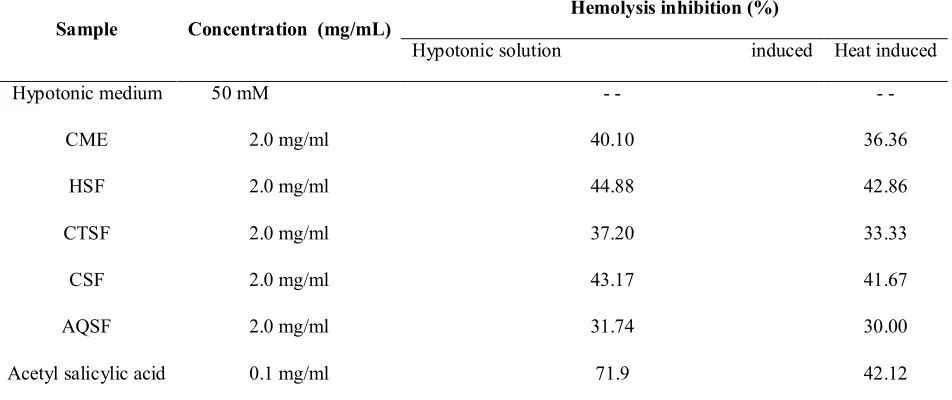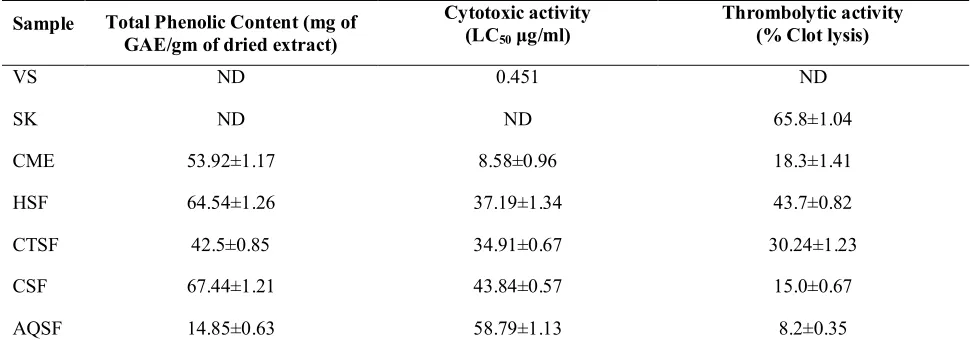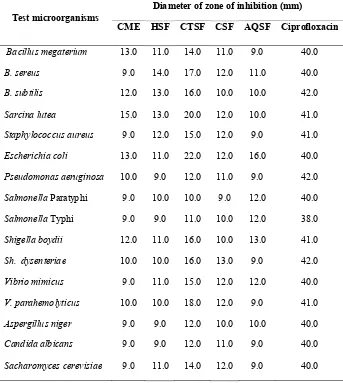ISSN 2278- 4136 ZDB-Number: 2668735-5
IC Journal No: 8192
Volume 1 Issue 4
Online Available at www.phytojournal.com
Journal of Pharmacognosy and Phytochemistry
Vol. 1 No. 4 2012 www.phytojournal.com Page | 57
Evaluation of Membrane Stabilizing Activity, Total Phenolic
Content, Brine Shrimp Lethality Bioassay, Thrombolytic and
Antimicrobial Activities of
Tagetes patula
L.
Md. Ruhul Kuddus1, Mirza Sonia Alam2, Sharmin Reza Chowdhury2, Farhana Rumi3, Md. Al Amin Sikder1, and Mohammad A. Rashid1*
1. Phytochemical Research Laboratory, Department of Pharmaceutical Chemistry, Faculty of Pharmacy,
University of Dhaka, Dhaka-1000, Bangladesh.
2. Department of Pharmacy, State University of Bangladesh, Dhaka-1205, Bangladesh.
3. Department of Pharmacy, Manarat International University, Mirpur-1, Dhaka-1217, Bangladesh.
Abstract: The methanol extract of leaf of Tagetes patula L. as well as its n-hexane, carbon tetrachloride, chloroform and aqueous soluble partitionates were subjected to screening for total phenolic content, brine shrimp lethality, membrane stabilizing, thrombolytic and antimicrobial activity. The membrane stabilizing activity was assessed by hypotonic solution-and heat-induced methods and was compared with acetyl salicylic acid. In the present studies, the n-hexane soluble fraction demonstrated strong membrane stabilizing activity in both hypotonic solution-and heat-induced methods with 44.48% and 42.68% inhibition of haemolysis, respectively. The total phenolic content was also determined andexpressed in gallic acid equivalent. In brine shrimp bioassay, the crude methanol extract of leaf showed strong cytotoxic activity with LC50 value of 8.58 μg/ml compared to that of 0.451 μg/ml exhibited by standard vincristine sulphate. During assay for thrombolytic activity, the n-hexane soluble fraction revealed 43.7% lysis of clot while standard streptokinase and water, used as positive and negative controls, demonstrated 65.8% and 3.62% lysis of clot, respectively. In antimicrobial assay by disc diffusion method, all the samples exhibited moderate to significant antimicrobial activity (zone of inhibition = 9.0-22.0 mm) against all the test organisms. Among all the samples, the carbon tetrachloride soluble fraction displayed strong antimicrobial activity against Escherichia coli (22.0 mm).
Keyword: Tagetes patula L, Membrane Stabilizing, Total Phenolic Content, Brine Shrimp Lethality, Thrombolytic, Antimicrobial.
Corresponding Author’s Contact information: Mohammad A. Rashid *
Phytochemical Research Laboratory, Department of Pharmaceutical Chemistry, Faculty of Pharmacy, University of Dhaka, Dhaka-1000, Bangladesh
E-mail: [email protected]
INTRODUCTION:Tagetes patula L. (Family: Asteraceae or Compositae,) commonly known as Genda, is native to South America but introduced and naturalized in most parts of the world and currently is a cosmopolitan ornamental plant. It is
a common garden plant1. The plant and its
Vol. 1 No. 4 2012 www.phytojournal.com Page | 58
diseases and hepatic disorders2. Furthermore,
divergent biological activities such as
antibacterial, antifungal, insecticidal, nematicidal and larvicidal3-7 have been devoted to the active principles of this plant. Essential oils and acetylenic thiophenes derived from roots are the most important secondary metabolites of French
marigold7. Monoterpenes, sesquiterpenes and
α-terthienyl have been reported as the main
ingredients of the herb and roots of T. patula,
respectively8,9. The insecticidal and nematicidal
activities of this plant are due to the presence of high levels of sesquiterpenes and thiophene compounds in the essential oil and organic solvent extracts of roots3.
As part of our ongoing research with medicinal
plant of Bangladesh,10-12 the present study has
been undertaken to evaluate the membrane stabilization, total phenolic content, brine shrimp
lethality, thrombolytic and antimicrobial
activities of T. patula as well as to find out the logical evidence for its folk uses.
MATERIALS AND METHODS
Plant materials
The leaves of T. patula were collected from
Mirpur in August 2010. A voucher specimen (Accession no. 35455) for this plant has been maintained in Bangladesh National Herbarium, Dhaka, Bangladesh for future reference.
The samples were sun dried for several days and then oven dried for 24 hours below 40 °C to facilitate grinding. The powdered materials (500 gm) were macerated in 2.0 L of methanol for 7 days and then filtered through a cotton plug followed by Whatman filter paper number 1. The extract was concentrated with a rotary evaporator at low temperature (40-45 ºC) and reduced pressure. The concentrated methanol extract was
partitioned by the modified Kupchan method13
and the resultant partitionates i.e., n-hexane (1.2 gm), carbon tetrachloride (1.0 gm), chloroform (800 mg), and aqueous soluble (1.6 gm) fractions were used for the experiment.
Membrane stabilizing activity:The erythrocyte
membrane resembles to lysosomal membrane and as such, the effect of drugs on the stabilization of erythrocyte could be extrapolated to the
stabilization of lysosomal membrane14. The
membrane stabilizing activity of the extractives was assessed by using hypotonic solution-induced and heat-solution-induced mice erythrocyte
haemolysis15. To prepare the erythrocyte
suspension, whole blood was obtained using syringes (containing anticoagulant EDTA) from mice through cardiac puncture. The blood was centrifuged and blood cells were washed three times with 154 mM NaCl in 10 mM sodium phosphate buffer (pH 7.4) through centrifugation for 10 min at 3000 g.
Hypotonic solution-induced haemolysis: The
test sample comprised of stock erythrocyte (RBC) suspension (0.50 ml) mixed with 5 mL of mixed with hypotonic buffered saline alone. The mixture was incubated for 10 min at room
temperature, centrifuged for 10 min at 3000 g and
the absorbance of the supernatant was measured at 540 nm. The percentage inhibition of either haemolysis or membrane stabilization was calculated using the following equation-
Vol. 1 No. 4 2012 www.phytojournal.com Page | 59
suspension (30 μl) was added to each tube and mixed by gentle inversion. A pair of the tubes was incubated at 54 ºC for 20 min in a water bath. The other pair was maintained at 0-5 ºC in an ice bath. The reaction mixture was centrifuged for 3
min at 1300g and the absorbance of the
supernatant was measured at 540 nm. The
percentage inhibition or acceleration of hemolysis in tests was calculated according to the equation:
% Inhibition of hemolysis = 100 x [1- (OD2-OD1/ OD3
-OD1)]
where, OD1 = optical density of unheated test sample, OD2 =
optical density of heated test sample and OD3 = optical density of
heated control sample
Table 1: Effect of extractives of leaf of T. patula on hypotonic solution-and heat-induced haemolysis of erythrocyte membrane.
Sample Concentration (mg/mL)
Hemolysis inhibition (%)
Hypotonic solution induced Heat induced
Hypotonic medium 50 mM - - - -
CME 2.0 mg/ml 40.10 36.36
HSF 2.0 mg/ml 44.88 42.86
CTSF 2.0 mg/ml 37.20 33.33
CSF 2.0 mg/ml 43.17 41.67
AQSF 2.0 mg/ml 31.74 30.00
Acetyl salicylic acid 0.1 mg/ml 71.9 42.12
Here, CME = Crude methanolic extract; HSF = Hexane soluble fraction; CTSF = carbon tetrachloride soluble fraction; CSF= chloroform soluble fraction; AQSF = aqueous soluble fraction of the methanolic extract of T. patula.
Total phenolics analysis: The total phenolic
content of T. patula was measured by employing
the method16 involving Folin- Ciocalteu reagent
as an oxidizing agent and gallic acid as standard. To 0.5 ml of extract solution (2.0 mg/ml) in water, 2.5 ml of Folin-Ciocalteu reagent (diluted 10 times with water) and 2.0 ml of sodium carbonate (7.5% w/v) solution were added. After 20 minutes of incubation at room temperature, the absorbance was measured at 760 nm using a UV-visible spectrophotometer. Total phenolics were quantified with the help of calibration curve
obtained from gallic acid (0-100 μg/ml). The
phenolics content of the sample was expressed as mg of GAE (gallic acid equivalent)/gm of the dried extract.
Cytotoxicity screening: Dimethyl sulfoxide
(DMSO) solutions of the extractives were applied
against Artemia salina in a one-day in vitro
assay17. For the experiment, 4 mg of each of the
Kupchan fractions was dissolved in DMSO and solutions of varying concentrations such as 400, 200, 100, 50, 25, 12.50, 6.25, 3.125, 1.563, 0.78125 μg/ml were obtained by serial dilution technique. Vincristine sulphate and DMSO were used as the positive and negative control, respectively.
Thrombolytic activity:The thombolytic activity
of all extractives was evaluated by the method18
Vol. 1 No. 4 2012 www.phytojournal.com Page | 60
Aliquots (5 ml) of venous blood were drawn from healthy volunteers which were distributed in five different pre weighed sterile micro centrifuge tube (1 ml/tube) and incubated at 37 °C for 45 minutes. After clot formation, the serum was completely removed without disturbing the clot and each tube having clot was again weighed to determine the clot weight (Clot weight = weight of clot containing tube – weight of tube alone). To each microcentrifuge tube containing pre-weighed clot, 100 μl aqueous solutions of different partitionates along with the crude extract was added separately. As a positive control, 100 incubation, the released of fluid was removed and tubes were again weighed to observe the
difference in weight after clot disruption. The differences in weights taken before and after clot lysis were expressed as percentage of clot lysis as shown below:
% of clot lysis = (wt of clot after lysis /clot wt) × 100
Antimicrobial activity: The preliminary
antimicrobial activity of the extractives was determined at 400 μg/disc by the disc diffusion
method19 against a number of Gram positive and
Gram negative bacteria and fungi (Table-3). The bacterial and fungal strains used in this
Table 2: Total phenolic content, cytotoxic activity (LC50μg/ml) and thrombolytic activity (% Clot lysis) of different
Kupchan fractions of T. patula.
Sample Total Phenolic Content (mg of GAE/gm of dried extract)
CTSF 42.5±0.85 34.91±0.67 30.24±1.23
CSF 67.44±1.21 43.84±0.57 15.0±0.67
AQSF 14.85±0.63 58.79±1.13 8.2±0.35
Here, VS= Vincristine sulphate, SK = Streptokinase, ND = Not determined
RESULTS AND DISCUSSION:
The present study was undertaken to evaluate the membrane stabilization, total phenolic content, brine shrimp lethality bioassay, thrombolytic and antimicrobial activities of the organic soluble materials of a methanol extract of T. patula and the results have been summarized in Table 1-3.
The extractives of T. patula, at concentration 2.0
mg/ml, significantly protected the lysis of mice erythrocyte membrane induced by hypotonic solution and heat, as compared to the standard acetyl salicylic acid (0.10 mg/ml) (Table 1). In
hypotonic solution-induced haemolysis, the
Vol. 1 No. 4 2012 www.phytojournal.com Page | 61
respectively as compared to 71.9% produced by acetyl salicylic acid. The methanolic crude extract also revealed significant inhibition of haemolysis of RBCs. On the other hand, in heat induced haemolysis, both the hexane soluble
fraction (HSF) and chloroform soluble fraction inhibited 42.86% and 41.67% haemolysis of RBC, respectively as compared to 42.1% produced by acetyl salicylic acid.
Table 3: Antimicrobial activity of T. patulaextractives at 400 μg/disc.
Test microorganisms
Diameter of zone of inhibition (mm)
CME HSF CTSF CSF AQSF Ciprofloxacin
Bacillus megaterium 13.0 11.0 14.0 11.0 9.0 40.0
B. sereus 9.0 14.0 17.0 12.0 11.0 40.0
B. subtilis 12.0 13.0 16.0 10.0 10.0 42.0
Sarcina lutea 15.0 13.0 20.0 12.0 10.0 41.0
Staphylococcus aureus 9.0 12.0 15.0 12.0 9.0 41.0
Escherichia coli 13.0 11.0 22.0 12.0 16.0 40.0
Pseudomonas aeruginosa 10.0 9.0 12.0 11.0 9.0 42.0
Salmonella Paratyphi 9.0 10.0 10.0 9.0 12.0 40.0
Salmonella Typhi 9.0 9.0 11.0 10.0 12.0 38.0
Shigella boydii 12.0 11.0 16.0 10.0 13.0 41.0
Sh. dysenteriae 10.0 10.0 16.0 13.0 9.0 42.0
Vibrio mimicus 9.0 11.0 15.0 12.0 12.0 40.0
V. parahemolyticus 10.0 10.0 18.0 12.0 9.0 41.0
Aspergillus niger 9.0 9.0 12.0 10.0 10.0 40.0
Candida albicans 9.0 9.0 12.0 11.0 9.0 40.0
Sacharomyces cerevisiae 9.0 11.0 14.0 12.0 9.0 40.0
The total phenolic content (TPC) varied for different Kupchan fractions of methanolic extract ranging from 14.85 to 67.44 mg of GAE/gm of dried extract (Table-2). The highest total phenolic was found in chloroform soluble fraction (67.44 mg of GAE/gm of extractives) demonstrating the significant antioxidant potentials. The hexane soluble Kupchan fraction and crude methanol extract revealed moderate antioxidant activity. The lowest phenolic was seen in aqueous soluble fraction (14.85 mg of GAE/gm of extractives).
In brine shrimp lethality bioassay, the crude methanol extract showed strong cytotoxic activity
with LC50 value of 8.58 μg/ml while the carbon
tetrachloride, n-hexane, chloroform and aqueous
soluble fraction were also moderately cytotoxic
with LC50 values of 34.91, 37.19, 43.84 and 58.79
Vol. 1 No. 4 2012 www.phytojournal.com Page | 62
In order to identify the drugs with the ability to promote lysis of blood clot from natural sources,
the extractives of T. patula were assessed for
thrombolytic activity. Addition of 100 μl streptokinase (SK), a positive control (30,000 I.U.) to the clots of human blood and subsequent incubation for 90 minutes at 37 °C, showed samples showed mild to moderate activity where the hexane and carbon tetrachloride soluble fractions exhibited 43.7 ± 0.82 and 30.24 ± 1.23 clot lysis, respectively (Table-2).
During screening for antimicrobial activity, all the samples exhibited moderate antimicrobial activity (zone of inhibition = 9.0-22.0 mm) against the test organisms. The crude methanolic extract exhibited moderate antimicrobial activity
against Sarcina lutea (15.0 mm), Bacillus
megaterium (13.0 mm) and Escherichia coili
(13.0 mm) while the n-hexane soluble fraction
showed maximum activity against Bacillus sereus
(14.0 mm). Among all the samples, the carbon tetrachloride soluble fraction displayed strong
antimicrobial activity against Escherichia coli
(22.0 mm), Sarcina lutea (20.0 mm), Vibrio
parahemolyticus (18.0 mm). The aqueous soluble fraction was found to be active against
Escherichia coli (16.0 mm) while the chloroform soluble fraction revealed little activity against the test organisms.
ACKNOWLEDGMENT:
The authors wish to thank the authority of the Institute of Nutrition and Food Science (INFS), University of Dhaka, Bangladesh for supplying test organisms to perform these investigations.
REFERENCE:
1. Ghahreman A, Plant systematics: Cormophytes
of Iran, Iran University Press, Iran, 1993, p. 842. (In Persian).
2. Rondon M, Velasco J, Hernandez J, Pecheneda
M, Rojas J, Morales A, Carmona J, Diaz T. Chemical composition and antibacterial activity of the essential oil of Tagetes patula L. (Asteraceae) collected from the Venezuela
Andes. Revista Latinoamericana de Química
2006; 34:32-36.
3. Bakker J, Gommers FJ, Nieuwenhuis I, Wynberg
H. Photoactivation of the nematicidal
compound alpha-terthienyl from roots of marigolds (Tagetes species). A possible singlet oxygen role. J. Biol. Chem 1979; 254: 1841-1844.
4. Dharmagadda VSS, Naik SN, Mittal PK,
Vasudevan P. Larvicidal activity of Tagetes
patula essential oil against three mosquito
species. Bioresource Technol 2005; 96: 1235-1240.
5. Kyo M, Miyauchi Y, Fujimoto T, Mayama S.
Production of nematicidal compounds by hairy root cultures of Tagetes patula L. Plant Cell Rep
1990; 9: 393-397.
6. Romagnoli C, Bruni R, Andreotti E, Rai MK,
Vicentini CB, Mares D. Chemical
characterization and antifungal activity of essential oil of capitula from wild Indian
Tagetes patula L. Protoplasma 2005; 225: 57-65.
7. Szarka S, Hethelyi EB, Lemberkovics E,
Balvanyos I. Essential oil constituents of intact plants and in vitro cultures of Tagetes patula L.
J. Essen. Oil Res 2007b; 19: 85-88.
8. Szarka S, Hethelyi E, Lemberkoviks E,
Kuzovkina IN, Banyai P, Szoke E. GC and GC-MS studies on the essential oil and thiophenes from
Tagetes patula L. Chromatographia 2006; 63:
10. Kuddus MR, Aktar F, Miah MK, Baki MA, Rashid
MA. Polyphenols content, cytotoxic, membrane stabilizing and thrombolytic activities of
Sarcolobus globosus: A medicinal plant from
Sundarban forest. Bol. Latinoam. Caribe
Plant. Med. Aromat2011; 10: 363-368.
11. Kuddus MR, Rumi F, Kaisar MA, Rahman MS,
Vol. 1 No. 4 2012 www.phytojournal.com Page | 63 metabolites from Melocanna Baccifera (Roxb.).
Asian J. Chem2011; 23: 85-88.
12. Sikder MAA, Millat MS, Sultana S, Kaisar MA, Rashid MA. In vitro membrane Stabilizing Activity, Total Phenolic Content, Cytotoxic, Thrombolytic and Antimicrobial Activities of
Calliandra surinamensis (Wall.). Journal of
Pharmacognosy and Phytochemistry 2012; 1 (3) :45-50.
13. Van Wagenen BC, Larsen R, Cardellina JH, Ran dazzo D, Lidert ZC, Swithenbank C. Ulosantoin, a potent insecticide from the sponge Ulosa
ruetzleri. J. Org. Chem 1993; 58: 335-337.
14. Omale J, Okafor PN. Comparative antioxidant
capacity, membrane stabilization, polyphenol composition and cytotoxicity of the leaf and stem of Cissus multistriata. Afr. J. Biotechnol.
2008; 7: 3129-3133.
15. Shinde UA, Phadke AS, Nair AM, Mungantiwar AA, Dikshit VJ, Saraf MN. Membrane stabilizing activity-a possible mechanism of action for the anti-inflammatory activity of Cedrus deodara
wood oil. Fitoterapia 1999; 70: 251-257.
16. Brand-Williams W, Cuvelier ME, Berset C. Use of free radical method to evaluate antioxidant activity. Lebensm Wiss Technol 1995; 28: 25-30.
17. Meyer BN, Ferrigni NR, Putnam JE, Jacobsen JB,
Nicholsand DE, Mclaughlin JL. Brine shrimp; a convenient general bioassay for active plant constituents. Planta Med 1982; 45: 31-4.
18. Prasad S, Kashyap RS, Deopujari JY, Purohit HJ, Taori GM, Daginawala HF. Development of an in vitro model to study clot lysis activity of thrombolytic drugs. Thrombosis J 2006; 4: 14.
19. Rahman MS, Rashid MA. Antimicrobial activity and cytotoxicity of Eclipta prostrate. Orient.


